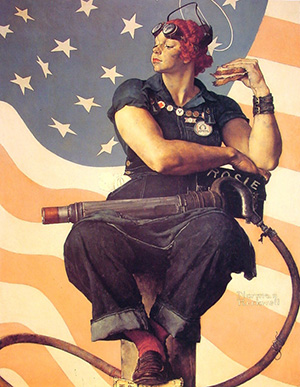It’s three months out from pub day for Poster Girl, which deals with World War II era Rosie the Riveter and lesser known Wendy the Welder propaganda campaigns. I’d like to mark the day by sharing a smidge of background.
In 1942, as American men went off to fight in World War II, the U.S. expected a significant worker shortage, which threatened to cripple the nation’s productivity. The Bureau of Labor Statistics projected that six million more workers would be needed by the end of 1943. It was obvious women should bridge that gap. So FDR’s Office of War Information (OWI), supported by private industry and media, created campaigns to urge women to take up jobs men were leaving behind, casting this as a beautiful, patriotic act. They figured it would be helpful to put faces to such an idea and began to feature such women in newspapers and magazines and movie reels.
In 1942, Redd Evans and John Jacob Loeb wrote a song,”Rosie the Riveter,” further popularized by bandleader Kay Kyser, cementing Rosie’s image as a dedicated, patriotic assembly line worker. The composers’ real-life inspiration for Rosie has been debated over the years. Several women, including Rosina Bonavita, Rosalind P. Walter, Adeline Rose O’Malley, and Rose Will Monroe, have been pitched as the real Rosie. Monroe especially stands out, featuring as she does in films and posters that promoted women’s contributions to the war.
Then Norman Rockwell’s painting of Rosie the Riveter became the iconic face of the effort. He painted Rosie as a muscular woman, lunching with a rivet gun in her lap and Adolf Hitler’s Mein Kampf beneath her foot, symbolizing women’s fight against fascism. Rockwell’s art, inspired by Michelangelo’s depiction of Isaiah in the Sistine Chapel, landed on the cover of the Saturday Evening Post on May 29, 1943. Rockwell used 19-year-old telephone operator Mary Doyle Keefe as his model. Her image’s influence really amplified when the Post loaned it to the government for war bond drives.
J. Howard Miller contributed the familiar Westinghouse “We Can Do It!” poster, intended to boost morale among existing workers. Its connection to Rosie became prominent only in later years, especially after its rediscovery in the 1980s, when it evolved into a potent feminist symbol.
Despite the opportunity provided by the Rosie campaigns, the real diversity of the American wartime workforce, especially Black women, was systematically overlooked. Still, the initiatives worked at their main goal: from March 1941 to August 1944, women’s employment rose from 10.8 million to 18 million. It’s no surprise that these women typically earned less than their male counterparts and were the first to be replaced by returning soldiers after the war. Yet they didn’t forget their experience working in war-time. And the memory of what they could do reawakened in the women’s rights movement later.
The Rosie icon continues to evolve, reflecting more than just its original war-time message. In Sacramento, when one gym business painted over a beloved Rosie mural, the community rose up in complaint. But then the Wide Open Walls program sponsored a new Rosie mural to install instead, the work of artist Lauren YS, whose playful, cartoony-colorful style addresses stereotypical tropes with whimsy. You can find this mural at 1801 14th Street, Sacramento. Take a look and consider what messages you find in the art.

Leave A Comment